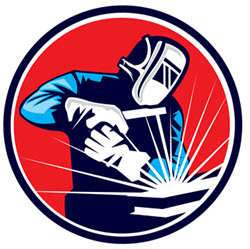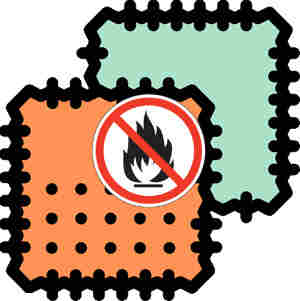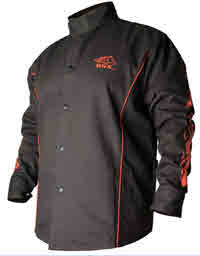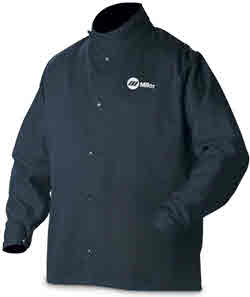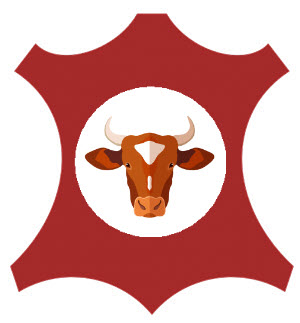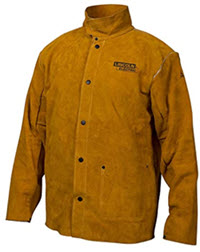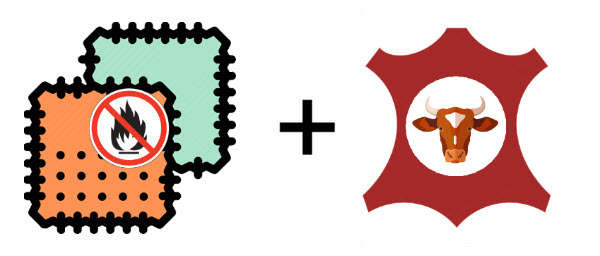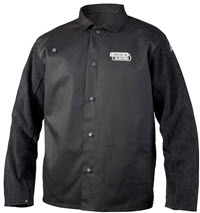Do You Need This Guide?
As you may already be aware, before evaluating various welding jackets (or any item, for that matter) for purchase it is important to have background knowledge on the subject. This ensures you get maximum value for your money and minimum post-purchase disappointment. This guide gives you that background knowledge on welding jackets.
The content of this guide is the result of hours of research followed by more hours discerning the grain from the chaff. In our opinion, unless you are in the welding jacket trade, you definitely will benefit from reading the guide.
In case you already have an idea of what you want, here are some useful jump links:
The Basic Buying Strategy
The strategy is simple:
- Decide on how much you can spend on a welding jacket
- Choose one with as many features as possible for that figure.
An Overview of Welding Jackets
Welding Jackets Minimize Risk
One of the solutions available for avoiding the above risks is the welding jacket, which is a preventive covering to the torso and arms of the welder (I say “one of the solutions” because components of a welding jacket are available separately, such as just the sleeves, or just neck and chest protection).
Welding jackets are in a broad sense similar to regular jackets but with certain enhancements.
How Welding Jackets are Different From Regular Jackets
Welding jackets are different from regular jackets in these ways:
- Their pockets are either taped closed or have a flap folded over them, to avoid capturing metal sparks which can then burn through to your skin
- They have high electrical resistance to prevent electrocution
- They are made of fire-retardant material (you can guess why)
- They have thermal insulation to protect your skin from being burned by the intense heat from infrared radiation generated by the welding arc.
Important Buying Guidelines
Types of Welding Jackets
Welding jackets are typically made out of the following materials:
- Flame-Retardant ('FR') Fabric Welding Jackets
- Leather Welding Jackets
- Fabric Torso, Leather Sleeves (‘Hybrid’) Welding Jackets
1. Flame-Retardant Fabric Welding Jackets
Let me start off with a caveat: a fabric welding jackets that are not flame-retardant (FR) are not an option (assuming you prefer not to catch fire).
Your preference should be for a medium-thickness fabric welding jacket. The marketplace makes them available in a variety of materials: FR cotton, FR cotton-nylon blends, sateen, and several proprietary fabrics like ‘Nomex’, ‘WeldX’ or ‘Weldas.’
Pros of FR Fabric Welding Jackets
Cons of FR Fabric Welding Jackets
Care of FR Fabric Welding Jackets
FR fabric welding jackets can be effectively washed in your home washing machine, subject to the following guidelines:
- Wash in warm water (up to 140 deg) using the ‘Normal' setting
- Keep the load light in the washer
- Wash the jacket inside-out to avoid white streaks caused by detergent caught in right-side fabric folds
- Use soft water (preferable but not mandatory)
- Tumble dry on the ‘Low’ setting or line dry it instead
- Feel free to press your jacket with the iron on the lowest temperature setting
- Read the garment label (if there is one). Care instructions on it supersede any of the instructions listed here.
Price Range
$11 - $50
Where to Buy FR Fabric Welding Jackets
We do not earn commissions if you make a purchase
Buyers’ Choices Based on Buyer Ratings
We only look at e-commerce websites which include customer ratings. For welding jackets, after an exhaustive search, only Amazon and Walmart satisfied that condition.
The number of stars is important. But so is the number of reviews (for instance, a 4-star rating with ten reviews is more meaningful than a 5-star rating with one review). We therefore multiply the number of reviews by the star rating to arrive at a ‘rating index’. The jacket with the greatest rating index is in our opinion the highest rated.
FR Cotton Welding Jacket
BSX BX9C Welding Jacket
Link to it (we do NOT make a commission on sales)
FR Cotton-Nylon Blend Welding Jacket
Miller Electric 2241909 Welding Jacket
Link to it (we do NOT make a commission on sales)
When to Choose an FR Fabric Welding Jacket
If your welding will be limited to light-duty with negligible spatter and not more than moderate heat (TIG, for instance), with no requirement to lie on your back, then an FR fabric jacket is what you should choose.
2. Leather Welding Jackets
Most leather welding jackets are made from ‘split leather’. A few words of explanation are called for to define that term.
‘Leather’ is basically the treated skin of an animal. There is cow leather (‘cowhide’), pig leather (‘pigskin’), calf leather (‘calfskin’) and a horde of other leathers (from goat, deer, lamb, reptiles et al). Since cowhide is what is used in almost all welding jackets, we will confine our discussion to cowhide, and call it simply ‘leather’ hereon unless otherwise specified.
Getting back to split leather, the hide that comes out of the tanning process (which prevents it from going bad) is so thick (0.2”- 0.4”) that it does not bend easily. If a jacket were made out of it, the arms would not flex, and it would be more a straitjacket than a welding jacket.
The solution is for the tannery to peel the hide into layers as in peeling an onion. The top layer is used for luxury goods like handbags, shoes and wallets because it is still rather stiff and because the beautiful grain is visible. The layer under it is called split leather, which is very flexible and abrasion-resistant, making it the ideal choice for welding jackets.
Pros of Leather Welding Jackets
Cons of Leather Welding Jackets
Care of Leather Welding Jackets
If there is slight to moderate soiling, do the following:
- Take a lint-free cloth, moisten it with mild soap (or saddle soap) and rub the jacket using strokes from the top of the jacket to the bottom, without soaking the jacket
- Alternatively, vacuum the jacket using a soft vacuum brush attachment
- If your jacket has a suede-like appearance, wet a cloth with suede cleaner and dab it on the stains you want to remove. Then take a suede brush and brush the suede cleaner you applied in the direction of the suede fibers (the ‘nap’) until the stain comes off.
- Read the garment label (if there is one). Care instructions on it supersede any of the instructions listed here.
If there is heavy soiling, follow this procedure instead:
- Turn the jacket inside out.
- Fill a large sink or plastic basin with slightly warm water. Mix in a small quantity of a detergent meant for washing delicates (such as Woolite)
- Totally immerse the jacket in the detergent solution, swish it around and then let it soak for about 10 minutes
- Brush away any tough soils with a soft brush
- Lift the jacket out and gently squeeze the soapy water out of it without wringing
- Fill the sink or basin with fresh water and rinse the jacket, replacing the water as many times as necessary to rinse out all the soap
- Turn the jacket right-side out and hang it up to dry indoors on a hangar (preferably of colorfast plastic) away from any heat sources (including sunlight)
- Be patient --- it may take a couple of days to completely dry
- Condition the jacket using a high-quality leather conditioner.
Price Range
$45 - $185
Where to Buy Leather Welding Jackets
We do not earn commissions if you make a purchase
Buyers’ Choices Based on Buyer Ratings
We only look at e-commerce websites which include customer ratings. For welding jackets, after an exhaustive search, only Amazon and Walmart satisfied that condition.
The number of stars is important. But so is the number of reviews (for instance, a 4-star rating with ten reviews is more meaningful than a 5-star rating with one review). We therefore multiply the number of reviews by the star rating to arrive at a ‘rating index’. The jacket with the greatest rating index is in our opinion the highest rated.
Lincoln Electric Brown Flame-Resistant Heavy Duty Leather Welding Jacket
Link to it (we do NOT make a commission on sales)
When to Choose a Leather Welding Jacket
You need a leather welding jacket if you:
- Doing heavy-duty welding
- Have to work lying on your back on a rough surface gravel or concrete
- Are subject to large-blob metal spatter or intense heat
- Are working in cold weather
- Are working in a hazardous environment like a ship
3. Fabric Torso, Leather Sleeves (‘Hybrid’) Welding Jackets
These keep your torso cool with FR fabric while the leather arms provide heavy-duty protection from the welding arc and its by-products (like heat and spatter) from cowhide or pigskin arms.
Pros of Hybrid Welding Jackets
Cons of Hybrid Welding Jackets
Care of Hybrid Welding Jackets
The method for cleaning a hybrid welding jacket is almost the same (but for the last step) as that used for a heavily soiled leather welding jacket: hand-washing. The steps are:
- Turn the jacket inside out.
- Fill a large sink or plastic basin with slightly warm water. Mix in a small quantity of a detergent meant for washing delicates (such as Woolite)
- Totally immerse the jacket in the detergent solution, swirl it around and then let it soak for about 10 minutes
- Brush away any tough soils with a soft brush
- Lift the jacket out and gently squeeze the soapy water out of it without wringing
- Fill the sink or basin with fresh water and rinse the jacket, replacing the water as many times as necessary to rinse out all the soap
- Turn the jacket right-side out and hang it up to dry indoors on a hangar (preferably of colorfast plastic) away from any heat sources (including sunlight)
- Be patient --- it may take a couple of days to completely dry
- Condition the sleeves of the jacket using a high-quality leather conditioner.
Price Range
$45 - $185
Where to Buy Hybrid Welding Jackets
Buyers’ Choice Based on Buyer Ratings
We only look at e-commerce websites which include customer ratings. For welding jackets, after an exhaustive search, only Amazon and Walmart satisfied that condition.
The number of stars is important. But so is the number of reviews (for instance, a 4-star rating with ten reviews is more meaningful than a 5-star rating with one review). We therefore multiply the number of reviews by the star rating to arrive at a ‘rating index’. The jacket with the greatest rating index is in our opinion the highest rated.
Lincoln Electric K3106 Split Leather Sleeved Welding Jacket
Link to it (we do NOT make a commission on sales)
When to Choose a Hybrid Welding Jacket
FR fabric welding jackets suffice for light welding, but if you want the extra protection of leather sleeves and can afford the extra cost, go right ahead and choose a hybrid welding jacket.
Conclusion
We hope you think, as we do, that this article is thoroughly researched and well written --- in short, of very high quality. We put the same high quality into our structural steel detailing service, and hope that you will try it out soon. Learn more about it here:
Alternatively, you can contact us right now using the contact form on this page.
Either way, we look forward to hearing from you!


